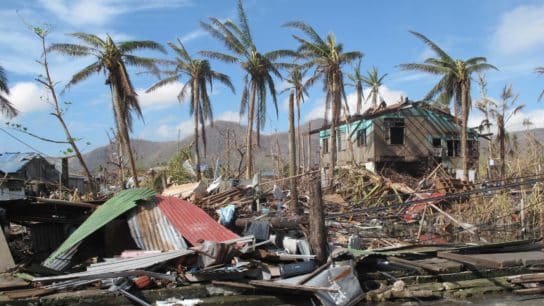Extreme weather events that World Weather Attribution researchers confirmed to be linked to climate change this year, including heatwaves, killed at least 3,700 people and displaced millions.
—
Climate change has boosted extreme heat globally in 2024, according to new study published at the end of the hottest year on record.
Researchers at World Weather Attribution (WWA) and Climate Central found that the average person experienced 41 additional days of dangerous heat fuelled by human-made climate change this year.
Dangerous heat days are defined as days when temperatures exceed the threshold temperature for the warmest 10% of temperatures observed over the 1991-2020 period. These days are linked to the local minimum mortality temperature, indicating a heightened risk to human health.
The highest number of people exposed to temperatures believed to have been made at least two times more likely to occur in today’s climate was 5.3 million on July 21, the hottest day on record at the time.
Countries closest to the equator were particularly affected, with climate-vulnerable Small Island Developing States (SIDS) residents experiencing more than 130 additional risky heat days.
SIDS are increasingly at risk from climate hazards, including sea level rise, intense cyclones, heavy rainfall, heatwaves, and droughts, despite contributing only 0.02% of global emissions.

But higher temperatures have also intensified other extreme weather events globally, as demonstrated in the dozens of attribution studies carried out by WWA this year. Together, the 29 events the group analyzed resulted in at least 3,700 deaths and the displacement of millions of people.
For example, the group found that an “exceptional” drought affecting Italy’s two major islands this year was made some 50% more likely by climate change-induced warming. More than 33,000 people working in the agricultural sector lost their job during the first trimester of 2024 owing to exceptionally dry and hot conditions, while dozens of municipalities were affected by months-long water rationing orders.
Many other regions of the world, including North and South America, parts of Europe and Africa are currently experiencing widespread drought conditions owing to extreme heat, which are exacerbating food and water security and displacing millions of people.

Exceptional drought conditions affecting the Americas this year have increased the likelihood of the occurrence of large wildfires, the EU Copernicus Atmosphere Monitoring Service said earlier this month. The agency confirmed that the Pantanal wetlands, the Amazon basin, Canada and the western US all experienced “particularly intense wildfires” in 2024.
Meanwhile, exceptionally warm seas fueled more destructive storms, including Hurricane Helene in the US and Typhoon Gaemi in southeast Asia. The two storms resulted in more than 300 fatalities and racked up nearly US$60 billion in damages.
Though storms are a rather common weather phenomenon, their intensity has increased exponentially in recent decades. The tred is attributed largely to rising ocean temperatures, which create the perfect conditions for storms to form and intensify.
An analysis by Climate Central published last month concluded that ocean warming fueled by human-made climate change has intensified all hurricanes in the Atlantic this year, increasing their highest sustained wind speeds by 9 to 28 mph (14.5 to 45 km/h).
This year's record-breaking temperatures also translated to record-breaking downpours and deadly floods affecting many parts of the world, including Brazil, Spain and several central European nations, Nepal, Bangladesh, Kenya and Tanzania.
You might also like: Floods and Droughts Driving Increasing Displacement in Africa: Report
"The past 12 months have provided an unprecedented cascade of heatwaves and floods, wildfires and droughts, underscoring the dangerous reality of living in a 1.3°C warmer world than when we started burning fossil fuels," the study's authors said, warning that, as the world continues to warm, the likelihood, frequency, and intensity of such events are only expected to increase further.
Earlier this month, European scientists confirmed that 2024 will be the hottest year ever recorded, beating 2023. It will also be the first above 1.5C, the critical global warming temperature threshold set in the Paris Agreement.
While this does not signal a permanent breach of the critical limit, which scientists say is measured over decades, it sends a clear warning to humanity that we are approaching the point of no return much faster than expected.
This story is funded by readers like you
Our non-profit newsroom provides climate coverage free of charge and advertising. Your one-off or monthly donations play a crucial role in supporting our operations, expanding our reach, and maintaining our editorial independence.
About EO | Mission Statement | Impact & Reach | Write for us














